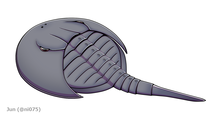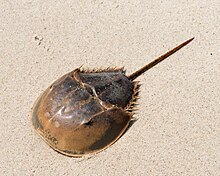
Back سيفيات الذيل Arabic سيفيات الذيل ARZ Мечахвосты Byelorussian Мечоопашати раци Bulgarian Xifosurs Catalan Xiphosura CEB Ostrorepi Czech Хĕçле хÿрелли CV Ξιφόσουρα Greek Xiphosura Spanish
| Xiphosura Temporal range: Earliest Hirnantian–Present,
| |
|---|---|

| |
| Restoration of Lunataspis, the oldest known xiphosuran | |

| |
| The extant Atlantic horseshoe crab (Limulus polyphemus) | |
| Scientific classification | |
| Domain: | Eukaryota |
| Kingdom: | Animalia |
| Phylum: | Arthropoda |
| Subphylum: | Chelicerata |
| Clade: | Prosomapoda |
| Order: | Xiphosura Latreille, 1802 |
| Groups | |
| |
Xiphosura (/zɪfoʊˈsjʊərə/;[2] from Ancient Greek ξίφος (xíphos) 'sword', and οὐρά (ourá) 'tail', in reference to its sword-like telson) is an order of arthropods related to arachnids. They are more commonly known as horseshoe crabs (a name applied more specifically to the only extant family, Limulidae). They first appeared in the Hirnantian (Late Ordovician). Currently, there are only four living species. Xiphosura contains one suborder, Xiphosurida, and several stem-genera.
The group has hardly changed in appearance in hundreds of millions of years; the modern horseshoe crabs look almost identical to prehistoric genera and are considered to be living fossils. The most notable difference between ancient and modern forms is that the abdominal segments in present species are fused into a single unit in adults.
Xiphosura were historically placed in the class Merostomata, although this term was intended to encompass also the eurypterids, whence it denoted what is now known to be an unnatural (paraphyletic) group (although this is a grouping recovered in some recent cladistic analyses).[3] Although the name Merostomata is still seen in textbooks, without reference to the Eurypterida, some have urged that this usage should be discouraged.[4] The Merostomata label originally did not include Eurypterida, although they were added in as a better understanding of the extinct group evolved. Now Eurypterida is classified within Sclerophorata together with the arachnids, and therefore, Merostomata is now a synonym of Xiphosura.[5] Several recent phylogenomic studies place Xiphosura within Arachnida, often as the sister group of Ricinulei; included among them are taxonomically comprehensive analyses of both morphology and genomes, which have recovered Merostomata as a derived clade of arachnids.[6][7][8]
- ^ Cite error: The named reference
Lamsdell2020was invoked but never defined (see the help page). - ^ "Xiphosuran". Oxford English Dictionary (Online ed.). Oxford University Press. (Subscription or participating institution membership required.)
- ^ Garwood, Russell J.; Dunlop, Jason A. (2014). "Three-dimensional reconstruction and the phylogeny of extinct chelicerate orders". PeerJ. 2: e641. doi:10.7717/peerj.641. PMC 4232842. PMID 25405073.
- ^ H. B. Boudreaux (1979). Arthropod Phylogeny with Special Reference to Insects. John Wiley & Sons. pp. 1–320.
- ^ Lamsdell, James C. (2012-12-18). "Revised systematics of Palaeozoic 'horseshoe crabs' and the myth of monophyletic Xiphosura". Zoological Journal of the Linnean Society. 167 (1): 1–27. doi:10.1111/j.1096-3642.2012.00874.x. ISSN 0024-4082.
- ^ Sharma, Prashant P.; Ballesteros, Jesús A. (14 February 2019). "A Critical Appraisal of the Placement of Xiphosura (Chelicerata) with Account of Known Sources of Phylogenetic Error". Systematic Biology. 68 (6): 896–917. doi:10.1093/sysbio/syz011. PMID 30917194.
- ^ Ballesteros, Jesús A.; Santibáñez López, Carlos E.; Kováč, Ľubomír; Gavish-Regev, Efrat; Sharma, Prashant P. (2019-12-18). "Ordered phylogenomic subsampling enables diagnosis of systematic errors in the placement of the enigmatic arachnid order Palpigradi". Proceedings of the Royal Society B: Biological Sciences. 286 (1917): 20192426. doi:10.1098/rspb.2019.2426. ISSN 0962-8452. PMC 6939912. PMID 31847768.
- ^ Ballesteros, Jesús A; Santibáñez-López, Carlos E; Baker, Caitlin M; Benavides, Ligia R; Cunha, Tauana J; Gainett, Guilherme; Ontano, Andrew Z; Setton, Emily V W; Arango, Claudia P; Gavish-Regev, Efrat; Harvey, Mark S; Wheeler, Ward C; Hormiga, Gustavo; Giribet, Gonzalo; Sharma, Prashant P (2022-02-03). Teeling, Emma (ed.). "Comprehensive Species Sampling and Sophisticated Algorithmic Approaches Refute the Monophyly of Arachnida". Molecular Biology and Evolution. 39 (2): msac021. doi:10.1093/molbev/msac021. ISSN 0737-4038. PMC 8845124. PMID 35137183.
© MMXXIII Rich X Search. We shall prevail. All rights reserved. Rich X Search